It’s natural for your dog to become anxious during a storm. The loud noises, flashes of lightning, and heavy rain can be overwhelming and frightening to them.
Fortunately, there are several steps you can take to help make your pup feel safe and secure during a storm.
- Key Takeaway
- 13 Ways To Make Your Dog Feel Safe During a Storm
- Create a Safe Space or “Den”
- Use Calming Scents or Pheromones
- Employ Noise Reduction Strategies
- Distract with Toys or Games
- Provide Comfort Through Physical Contact
- Maintain a Calm Demeanor
- Use Pressure Wraps or Anxiety Vests
- Implement Desensitization Techniques
- Offer Treats and Positive Reinforcement
- Keep a Consistent Routine
- Secure All Doors and Windows
- Play Calming Music or White Noise
- Consult a Veterinarian for Severe Anxiety
- Should You Comfort a Dog During a Storm?
- What Does Storm Anxiety Look Like In Dogs?
- Should I Hug My Dog During a Storm?
- Should I Ignore My Dog During a Thunderstorm?
- In Conclusion
Key Takeaway
- Thunderstorm anxiety in dogs is a disorder characterized by a persistent and exaggerated fear of storms, involving reactions such as hiding, shaking, trembling, crying, or whining due to the combination of loud noises, barometric pressure changes, and low-frequency rumbles associated with storms.
- Ways to make your dog feel safe during a storm include creating a secure and comfortable space, providing distractions like toys and treats, staying calm to avoid transmitting anxiety, using anti-anxiety shirts, and gradually desensitizing them to storm sounds through low-volume recordings.
- Training a dog not to be scared of storms involves gradual desensitization to storm sounds through low-volume recordings, positive reinforcement during calm behavior, creating a safe and comfortable space for them during storms, and potentially consulting with a professional behaviorist or using calming aids like anti-anxiety wraps or medication.
What Is Thunderstorm Anxiety In Dogs
Thunderstorm anxiety in dogs is a condition where dogs exhibit signs of distress, fear, or panic during or in anticipation of thunderstorms.
Thunderstorm anxiety in dogs can manifest in various ways, including excessive barking or whining, hiding, trembling, panting, or even destructive behavior.
These symptoms are typically triggered by the loud noises of thunder, but changes in barometric pressure, lightning, and strong winds may also contribute to a dog’s anxiety.
From my personal experience as a veterinarian, I’ve observed that this condition can affect any breed, age, or gender of a dog, but it’s more common in certain breeds and older dogs.
It’s also worth noting that a dog’s past experiences, such as traumatic events associated with storms, can play a significant role in the development of thunderstorm anxiety.
13 Ways To Make Your Dog Feel Safe During a Storm
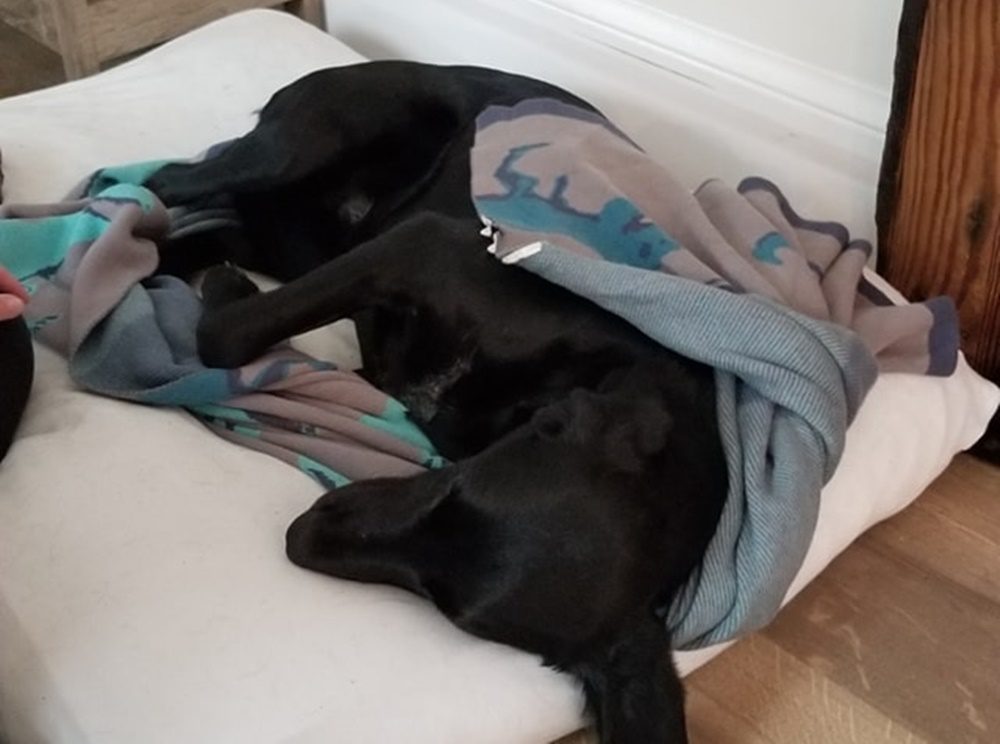
To ensure your dog feels safe during a storm, you should create a comforting environment, use soothing scents or sounds, provide distractions, and maintain a calm presence, among other strategies.
Create a Safe Space or “Den”
Creating a safe space for your dog can be very beneficial during a storm. This could be a crate, a specific room, or even just a cozy corner with their favorite blanket or bed. Make sure this area is easily accessible and free from any potential hazards.
Use Calming Scents or Pheromones
Using calming scents or dog-specific pheromone sprays can often help to soothe a dog’s anxiety during a storm. These scents mimic the natural pheromones produced by mother dogs to calm their puppies and can have a similar effect on adult dogs.
Employ Noise Reduction Strategies
Noise reduction strategies, like closing windows and drawing curtains, can help to dampen the sound of the storm. You can also use white noise machines or fans to create a consistent background noise that can mask the sound of thunder.
Distract with Toys or Games
Keeping your dog distracted with their favorite toys or games can also be helpful. This not only keeps their mind off the storm but also associates the experience with positive emotions.
Provide Comfort Through Physical Contact
Sometimes, all a scared dog needs is some comfort from their trusted human. If your dog is comfortable with it, try offering gentle strokes, pats, or even just sitting close to them.
Maintain a Calm Demeanor
Dogs are very attuned to the emotions of their humans. If you stay calm and do not show any signs of stress, this can help your dog to feel more relaxed during the storm.
Use Pressure Wraps or Anxiety Vests
Pressure wraps or anxiety vests work by applying gentle, constant pressure to a dog’s torso, which can have a calming effect. Many dog owners and veterinarians swear by these during storms.
Implement Desensitization Techniques
Desensitization involves gradually exposing your dog to the sounds of a storm in a controlled environment, which can help them to become less anxious over time. This should be done slowly and carefully, with plenty of positive reinforcement.
Offer Treats and Positive Reinforcement
Offering treats and positive reinforcement can help to create positive associations with the storm. This could involve giving your dog their favorite treat or lots of praise whenever a thunderclap occurs.
Keep a Consistent Routine
Keeping a consistent routine as much as possible can also be helpful. This includes regular feeding times, walks, and playtimes, even if the weather is bad.
Secure All Doors and Windows
Making sure all doors and windows are secure can prevent your dog from escaping in panic during a storm. It also helps to reduce the noise and sight of the storm.
Play Calming Music or White Noise
Playing calming music or white noise can help to mask the sounds of the storm and can have a soothing effect on many dogs.
Consult a Veterinarian for Severe Anxiety
Finally, if your dog’s anxiety is severe or causing them distress, it may be worth consulting a veterinarian. They can offer advice and potential treatment options, such as medication or behavioral therapy.
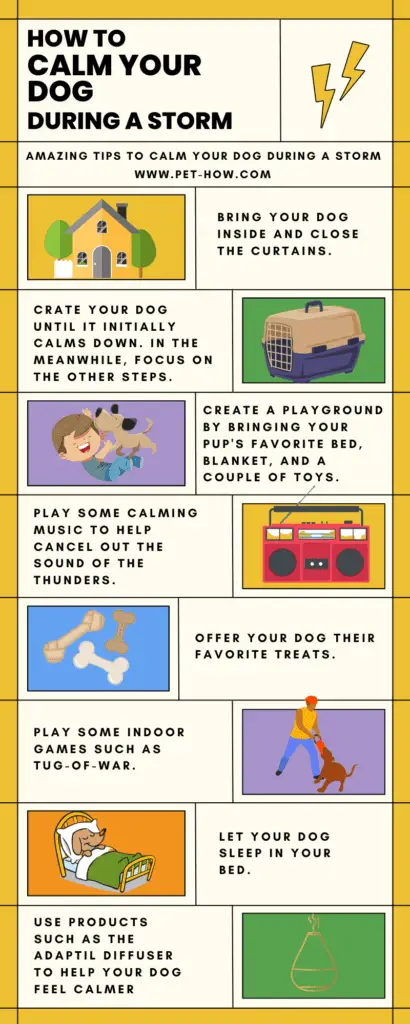
The Role of Exercise Before the Storm
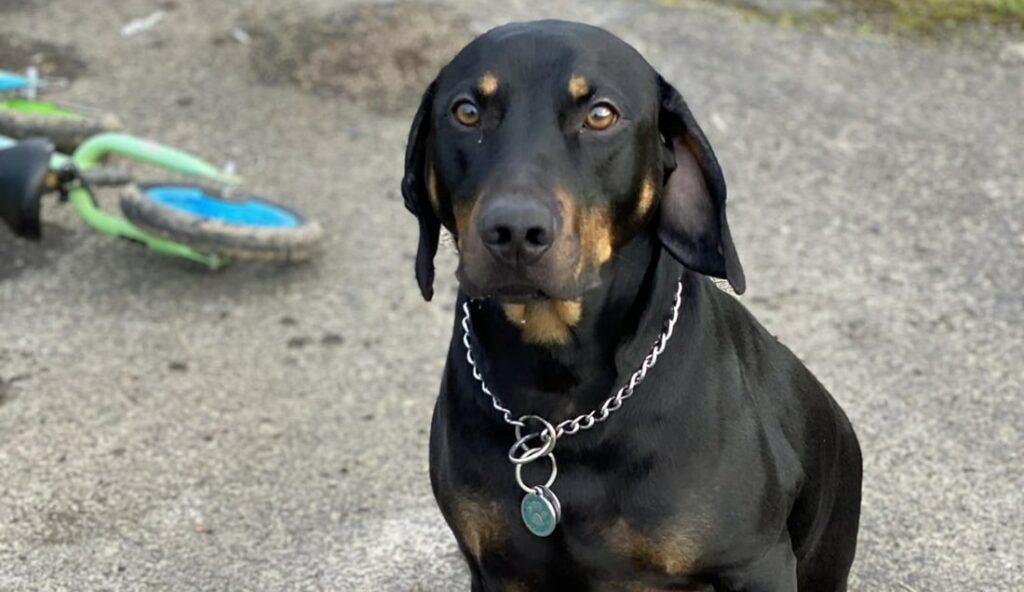
Exercise before a storm plays a significant role in helping dogs manage their storm anxiety, as it helps them expend energy and promotes calmness when the storm hits.
Engaging your dog in physical activity before the onset of a storm can be a highly effective method to alleviate their anxiety.
A well-exercised dog is likely to be more relaxed and less reactive to scary sounds and flashes of light that come with storms.
During exercise, dogs exert energy which generates heat and increases their cardiovascular and thermoregulatory demand. This process not only tires them physically but also mentally, making them more likely to sleep or rest during the storm, reducing their fear response.
From my experience as a vet, I’ve seen how beneficial a good workout can be for anxious dogs.
I remember a particular case where a client’s dog would become extremely agitated during storms, showing signs of severe anxiety such as trembling, panting, and destructive behavior.
Upon my advice, the owner started taking their dog for a long walk or play session before a predicted storm.
Over time, they noticed a significant reduction in their dog’s storm-related anxiety. The dog was calmer, rested, and showed fewer signs of distress during storms.
This goes to show that exercise can be a powerful tool in managing a dog’s fear of storms.
What Does Storm Anxiety Look Like In Dogs?

Storm anxiety in dogs typically manifests as behaviors such as vocalizing, drooling, loss of bladder or bowel control, destructive behavior, pacing, panting, trembling, whining or howling, seeking comfort from their human, and in severe cases, involuntary defecation or urination.
A dog might pace back and forth, howl uncontrollably, or continually bark at imaginary noises. It’s important to remember that these reactions aren’t their fault.
Some breeds of dogs seem to be more prone to storm anxiety than others and this can be both very distressing for pet owners as well as unpleasant for the dog itself.
Fortunately, there are steps that can be taken to help reduce fear and stress during storms, including desensitization techniques as well as natural remedies such as herbal extracts that can aid relaxation.
Playing relaxing music inside the house can muffle the sound of thunder while providing your pup with an open space they feel safe and secure in can also be beneficial. Snuggling up or offering treats are great ways to provide some extra comfort and reassurance during the storm.
Additionally, keeping a firm but gentle touch is important whenever calming your dog during turbulent times.
Building a Storm Kit for Dogs
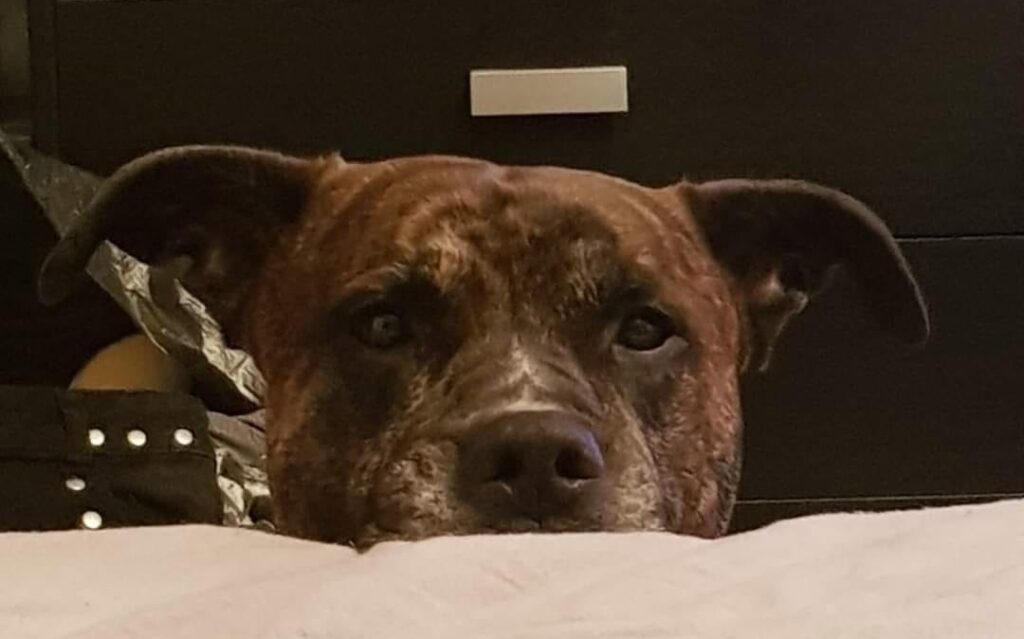
Building a storm kit for dogs involves assembling essential items that your pet may need during a storm, including comfort items, safety gear, and potentially, calming aids.
Comfort Items
Comfort items like your dog’s favorite toys, blankets, or bedding can provide a sense of security during a storm. These familiar items can help create a soothing environment for your dog.
In my practice, I’ve seen how providing these comfort items can significantly reduce a dog’s anxiety. For example, a client’s Golden Retriever had a favorite plush toy that seemed to calm him down during storms. Keeping this toy in their storm kit proved to be very effective.
Safety Gear
Safety gear such as a leash, harness, and a well-fitted collar with identification tags are vital components of a storm kit. If you need to evacuate or move to a safer location, these items ensure your dog is safe and secure.
One of my clients experienced a severe storm where they had to evacuate their home. Having these items readily available made the process less stressful for both the owner and the dog.
Calming Aids
Calming aids like anxiety wraps or herbal remedies can also be included in your storm kit. As mentioned earlier, these aids can help manage your dog’s storm anxiety.
I’ve recommended these to many pet owners, and they’ve been beneficial in keeping their pets calm during storms.
Food and Water
Don’t forget to include a supply of your dog’s regular food and fresh water in the storm kit. The stress of a storm can affect a dog’s appetite, so having familiar food available can help keep them nourished.
One of my clients had a Shih Tzu who would refuse to eat anything but his regular kibble during storms. Including this in their storm kit ensured that the dog remained well-fed despite his anxiety.
Medical Supplies
Finally, if your dog is on any medication, make sure to include a sufficient supply in your storm kit. This is crucial, especially if the storm prevents you from getting to a vet or pet store.
I’ve had clients who were thankful they had their pet’s medicine on hand when they couldn’t leave their home due to severe weather conditions.
In the end, the goal of a storm kit for dogs is to provide comfort and safety, helping to alleviate some of the stress associated with storms. As a vet, I’ve seen how effective these kits can be in managing a dog’s fear of storms.
How To Train a Dog Not To Be Scared of Storms
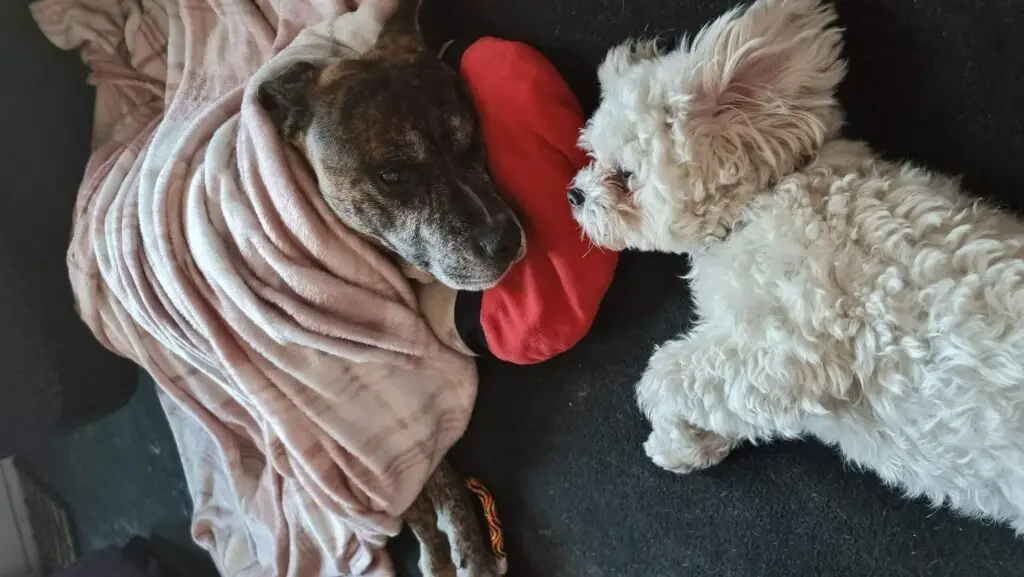
Training your dog not to be scared of storms involves a combination of creating a safe space, using distraction techniques, positive reinforcement, and in some cases, seeking professional help.
Create a Safe Space
Creating a safe space for your dog during a storm can significantly help reduce their anxiety. This could be a dedicated room, a crate, or even a blanket fort. Make sure this space is comfortable and filled with your dog’s favorite toys and blankets.
The idea is to create an environment where your dog feels secure and safe. In my experience as a vet, I’ve seen dogs that retreat to their safe spaces during a storm and come out when they feel the storm has passed.
Use Distraction Techniques
Distracting your dog during a storm can also help alleviate fear. This could involve playing with them, giving them a chew toy, or even turning on some soft music to mask the sound of the storm.
I’ve personally seen how effective these methods can be, especially with dogs that are heavily reliant on their owners for comfort.
Positive Reinforcement
Positive reinforcement involves rewarding your dog for calm behavior during a storm. This could be in the form of treats, praise, or cuddles.
The key is to reinforce the idea that storms aren’t something to be scared of. It’s a method I often recommend, and it’s been successful in many cases.
Seek Professional Help
If your dog’s fear of storms is severe, it might be necessary to seek professional help.
A professional dog trainer or a veterinary behaviorist can provide personalized training methods and solutions.
I’ve referred many pet owners to professionals when it’s clear that the fear is deeply ingrained and causing significant distress to the dog.
Why Are Dogs Afraid of Storms?
Dogs are often afraid of storms due to a combination of factors such as loud noises, changes in barometric pressure, and the build-up of static electricity in their fur.
This fear can manifest in various ways, including shaking, trembling, seeking cover, or displaying signs of anxiety.
It’s believed that the loud sounds associated with thunderstorms can be particularly distressing for dogs because they have a more acute sense of hearing than humans.
The sudden change in barometric pressure and the static electricity accumulating in their fur during a storm can also cause discomfort and fear.
Some dogs may even detect low-frequency rumbles from thunderstorms that are out of human hearing range, adding to their anxiety.
From my personal experience as a veterinarian, I’ve observed that every dog reacts differently to these elements.
Some may exhibit mild nervousness, while others may show extreme fear responses. It’s crucial to understand that this fear is a natural reaction to an unfamiliar and uncomfortable situation.
As pet owners, we can help our dogs cope by providing a safe space, maintaining a calm demeanor, and offering comfort without reinforcing the fearful behavior says Wikipedia.
Can I Give My Dog Benadryl Before a Storm?
While Benadryl is often used to help dogs with allergies or anxiety, it should only be given under the guidance of a veterinarian, especially as a preemptive measure before a storm.
Benadryl, also known as Diphenhydramine, is an antihistamine commonly used in humans and, to a lesser extent, in pets. It can help alleviate symptoms of allergies, and motion sickness, and in some cases, help reduce anxiety.
However, it’s important to remember that while Benadryl is generally safe for dogs, it’s not suitable for all dogs. Some dogs may have health conditions or be on medications that could negatively interact with Benadryl.
Furthermore, dosage is a critical factor. The dosage for dogs is not the same as for humans. Giving your dog the wrong amount could lead to serious health problems.
Therefore, it’s crucial to consult with a veterinarian before giving your dog Benadryl, especially as a measure to calm them before a storm.
From my personal experience as a veterinarian, I’ve seen cases where Benadryl has been beneficial in reducing a dog’s anxiety during a storm. However, it’s always been administered under professional guidance.
Alternative Therapies To Keep a Dog Calm During Storms
Alternative therapies to keep a dog calm during storms involve holistic treatments such as herbal remedies, anxiety wraps, and the use of calming music or white noise, among others.
Herbal Remedies
Herbal remedies like valerian root, chamomile, passionflower, and lavender have natural sedative properties that can help soothe an anxious dog during a storm.
I’ve recommended these herbs to many pet owners, and they’ve reported noticeable changes in their dog’s behavior.
One of my clients used a combination of chamomile and passionflower for their Labrador Retriever, who used to tremble and hide during thunderstorms.
After a few weeks of this regimen, they noticed a significant reduction in their dog’s storm anxiety, demonstrating the effectiveness of these natural solutions.
Anxiety Wraps
Anxiety wraps or thunder jackets are vest-like garments designed to apply gentle, constant pressure on a dog’s torso. This pressure has a calming effect similar to swaddling a baby.
I once treated a Border Collie with severe storm phobia, and the owner decided to try an anxiety wrap. To their surprise, the wrap had an immediate calming effect on their pet, and the dog was much less anxious during subsequent storms.
Calming Music or White Noise
Playing calming music or white noise can help mask the unsettling sounds of a storm and create a more relaxed environment for your dog.
I remember a case involving a Boxer with extreme storm anxiety. The owner started playing classical music during storms, and it significantly reduced the dog’s anxiety levels.
The dog became more relaxed and less responsive to the loud noises, indicating that this approach can be a useful tool in managing storm-related anxiety in dogs.
Consistent Schedule and Safe Spaces
Maintaining a consistent schedule and providing a safe space for your dog during storms can also be beneficial.
Regular exercise, feeding times, and play sessions contribute to a sense of normalcy and security, which can be comforting during a storm.
Providing a safe space, like a specific room or crate with their favorite toys and blankets, can also help them feel secure. In my practice, I’ve seen how this strategy can drastically reduce anxiety levels in dogs during storms.
Should I Hug My Dog During a Storm?
While the reaction can vary based on the individual dog, generally, providing comfort through physical touch such as hugging can help ease a dog’s anxiety during a storm, as long as the owner remains calm and composed.
During a storm, your pup may experience increased stress levels due to loud noises or sudden lightning flashes that could startle them. Giving them some extra hugs and cuddles radiates calmness and reassurance that everything is going to be alright!
When we hug our beloved dogs, most of us assume that the feeling is mutual. However, science tells us that there is more than meets the eye when an owner hugs their pup. Dogs have emotions and feelings just like us, and a hug from us can make them feel secure and loved.
Studies have also suggested that when humans interact with a dog in a positive manner such as by hugging or petting, it causes the dog’s brain to release oxytocin – a hormone associated with affection.
Additionally, this physical contact strengthens the bond between you and your furry friend. Hugging your dog during a storm helps build trust in their relationship with you. This initiates an atmosphere of mutual understanding and respect.
Should I Ignore My Dog During a Thunderstorm?
While it’s important not to reinforce fearful behavior, completely ignoring your dog during a thunderstorm isn’t recommended; instead, maintain a calm demeanor, provide a safe space, and offer comfort without overly fussing over them.
Many dogs become anxious and scared during a thunderstorm due to the loud noises, flashes of lightning, and feeling of uncertainty they provide.
Dogs have heightened senses of danger and storms present an unfamiliarly noisy and explosive environment that can cause panic in many animals.
Additionally, thunderstorms often come with strong wind gusts that can be physically uncomfortable for the pet and make them feel vulnerable.
In response to this, dogs may seek out their owners for reassurance or hide in small nooks or closets until the storm passes.
Long-term Solutions For Dogs That Are Afraid of Storms
Long-term solutions to help a dog cope with storm anxiety include creating a soundproof safe space and considering professional behavioral therapy.
Building a Soundproofed Safe Space
Creating a soundproofed safe space for your dog can be an effective long-term solution. This could be a specific room, a crate, or even a part of a room that’s been modified to reduce noise.
The idea is to create an environment where the sounds of the storm are significantly muffled. In this space, your dog can feel secure and less affected by the noise outside.
I recall a client who had a German Shepherd with severe storm anxiety. They converted a part of their basement into a soundproofed area for their dog.
Over time, the dog started retreating to this space during storms, and it drastically reduced his anxiety levels.
Professional Behavioral Therapy
Professional behavioral therapy is another potential long-term solution. A certified animal behaviorist or a trainer skilled in fear-based issues can work with your dog to help them cope with their fear of storms.
Techniques such as desensitization and counter-conditioning can be used to gradually expose your dog to the noises associated with storms in a controlled and non-threatening way.
One of my clients took their storm-phobic Border Collie to a professional behaviorist. After several sessions, they saw a significant improvement in their dog’s response to storms.
The dog was noticeably calmer and showed fewer signs of distress, indicating the effectiveness of professional intervention.
FAQs
Q: How can I calm my dog during a storm?
A: There are several tips to help calm your dog during a storm. You can create a safe and secure space for your dog, use white noise or calming music, try techniques such as desensitization and counterconditioning, and provide distractions such as toys or treats.
Q: What can I do if my dog is afraid of thunderstorms?
A: If your dog is afraid of thunderstorms, you can try various methods to help them feel more at ease. This can include creating a safe space, using calming tools, providing distractions, and seeking professional advice if the fear persists.
Q: Can training help calm my dog during a storm?
A: Yes, training can be beneficial in helping to calm your dog during a storm. This can involve teaching them positive associations with storms, practicing relaxation techniques, and gradually desensitizing them to storm-related sounds or stimuli.
Q: How does a thundershirt work to calm a dog during a storm?
A: A thundershirt is a garment designed to apply gentle pressure to a dog’s body, which has a calming effect on many dogs. It works similarly to swaddling an infant, providing a sense of security and reducing anxiety.
Q: What other remedies can I try to calm my dog during a storm?
A: In addition to creating a safe space and using tools like thundershirts, you can also explore other remedies such as natural supplements, pheromone sprays, or prescribed medications. It is always recommended to consult with your veterinarian before trying any new remedies.
Q: How can I help my dog before, during, and after a thunderstorm?
A: Before a thunderstorm, you can try to create a calm environment and provide distractions for your dog. During the storm, ensure they have a safe place to retreat to and use calming techniques. After the storm, offer comfort and reassurance to help them recover from any anxiety.
Q: What should I do if my dog gets scared during a storm?
A: If your dog gets scared during a storm, remain calm and offer reassurance. Avoid comforting them excessively, as it may reinforce their fear. Instead, try distracting them with toys or treats, and create a calm environment for them to relax in.
Conclusion and final thoughts
To make your dog feel safe during a storm, you need to bring your dog inside and create a calming ambient inside the house by playing some relaxing music.
Then, play some games to distract your dog from thinking about the thunderstorm.




